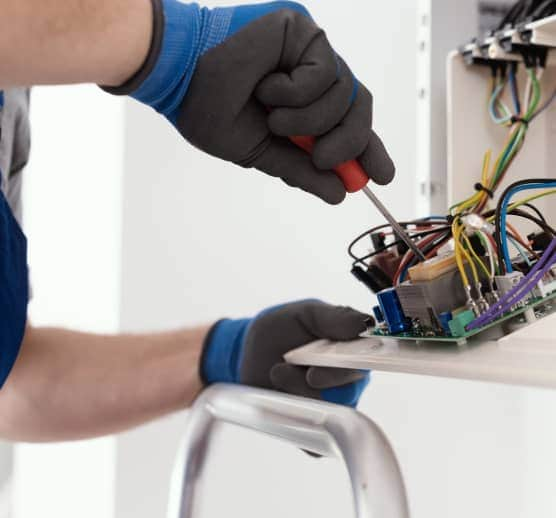Many homeowners worry about their boilers breaking down in the winter. It's that classic concern about waking up to a freezing house or a cold-water shower when it's icy outside. Winter brings out the inner worrywart in all of us!
Getting an error code from your boiler feels like it's speaking a secret language, and most people do not speak "boiler"! It's the fear of the unknown – not knowing if it's a simple fix or a sign of impending boiler doom. Plus, the timing is usually impeccable: error codes seem to love making an entrance in the dead of winter when you need your heating the most. It's like your boiler picked the worst possible moment to throw a tantrum.
In this article, we specifically look at the Worcester Bosch boiler fault code E9. We delve into what it means, the probable causes and workable solutions. Having this knowledge will mean you are a little more prepared if you experience this flashing error code over the winter. For expert help, turn to our boiler repair services in London.
What does the E9 fault code on a Worcester Bosch boiler mean?
The E9 fault code on a Worcester boiler is an overheat code. It signifies that the safety temperature limiter in the central heating (CH) flow has tripped.
To understand this, let’s break this explanation into plain English…
Your boiler has a safety feature called a temperature limiter. Think of it as a guardian that makes sure your boiler doesn't get too hot, such as over 105 degrees, which could fry its insides.
Now, this limiter has buddies – sensors – placed in two pipes coming out of your system. They're like the guards on the gates. If the temperature shoots up beyond the safe zone, these sensors (the guards) notice and raise the alarm.
So, when the sensor in the pipe where the hot water is heading out (that's the CH flow pipe) senses a fault, it activates and displays the E9 code. It's like your boiler's way of saying, "Houston, we've got a temperature problem in the central heating flow!"
Proudly Serving LondonFor Over 50 Years
What are the causes of the Worcester fault code E9?
There could be a few reasons why your boiler is overheating including a faulty heat exchanger, a blocked or broken pump, and faulty wiring and sensors. We would always advise getting your boiler investigated by a qualified gas safe engineer like our team at Maintracts Services.
The typical cause codes displayed along with the E9 fault code are:
- 219
- 220
- 221
- 224
One of the 3-digit codes listed above will sometimes flash along with the E9 fault code. If it doesn’t, press the return/spanner button, and your boiler should display the information.
The main causes why the E9 code is displayed are:
Faulty safety temperature limiter
If there is a hitch with the safety temperature limiter, the odds are it needs a replacement. Keep an eye out for either the 220 or 221 cause code – that's the telltale sign of this glitch. When this limiter goes rogue, it starts sending the wrong signals to the Printed Circuit Board (PCB), or in simpler terms, the control centre of your boiler.
So, if your safety temp limiter is acting up and confusing the PCB, you might see the E9 code pop up. It's like your boiler's way of letting you know it needs a break.
What’s the solution? Repair the safety temperature limiter. Typically, if the safety temperature limiter faults, it is recommended to replace it rather than attempting repairs for safety and performance reasons.
A blocked or faulty boiler pump
The boiler pump is responsible for circulating hot water throughout the heating system pipes, ensuring a consistent and even distribution of heat to different areas of the home.
In the event of pump malfunction or failure, the heated water stagnates within the system, undergoing further heating via the heat exchanger and subsequently leading to an undesirable overheating scenario.
Potential causative factors for pump malfunction include the presence of aged and corroded components which impede the free movement of mechanical parts or the accumulation of sludge obstructing the pump's operation.
It is noteworthy that in instances involving newer boiler systems, the occurrence of malfunctions often stems from wrong settings rather than something more serious.
What’s the solution? A heating engineer typically resolves a blocked or faulty boiler pump by identifying the issue, clearing any blockages, and, if necessary, repairing or replacing the pump to ensure proper circulation and system functionality.
Faulty safety temperature limiter
If you see a 219 cause code alongside your E9, then a faulty heat exchanger is to blame.
The role of the heat exchanger is to take the heat from the burning fuel and pass it on to the water without letting them mingle. It’s responsible for making sure the circulating water in your system is heating efficiently to make your home nice and warm without any combustion byproducts crashing the heating party. A temperature rise caused by the overheating of the exchanger fires up the fault code.
Limescale buildup, often occurring in regions with hard water and older boilers without adequate filters, is a frequent cause of overheating in heating systems.
Minerals in hard water accumulate as limescale within the heating system. This buildup causes affected components to operate at higher temperatures, impacting the accurate temperature regulation around the heat exchanger.
Unchecked limescale deposition poses an increased risk to the system, potentially causing damage such as cracks in the heat exchanger and leading to leaks. Regular boiler maintenance is crucial to prevent and address this issue.
What’s the solution? A heating engineer will conduct a thorough inspection, diagnose the issue, and replace the heat exchanger if necessary.
A damaged PCB
The Printed Circuit Board (PCB) is a crucial component in modern boilers – it’s the brains behind the operation. It serves as the central hub for controlling and coordinating various functions within the boiler system. Therefore, if one step in the process fails, the next step will not take place. The PCB is responsible for processing information from sensors and other components, making decisions based on that information, and sending signals to distinct parts of the boiler to regulate its operation. The PCB checks every nook and cranny of the heating process. If something seems off, it hits the emergency shut-off button, just to be safe.
Any damage to the PCB itself will also be registered as the E9 fault. So, the system will display the fault even when all the components such as the heat exchanger and pump are working well. If the PCB is damaged it may further complicate resolving the problem by displaying incorrect cause codes.
What’s the solution? A damaged PCB in a heating system is typically resolved through diagnosis, repair if possible, or replacement of the damaged PCB to restore the proper functioning of the boiler.
If the PCB is damaged beyond repair and needs to be replaced, it may make more sense to replace the boiler if it is quite old. This is because, repairs and replacements of the PCB can be quite costly, and an old system will only require more repairs slightly further down the line. A qualified heating engineer will be able to advise the best course of action for you.

For more information on common Worcester Bosch boiler error codes, click here.
If you are struggling with a faulting boiler, it’s always best to try and get the problem fixed before it escalates and leaves you without heat or hot water. If you would like to talk to a member of our family run team, contact us at your convenience.
Call 020 868 22244
to speak directly to an
experienced professional.
Delivering customer
excellence since 1974.

